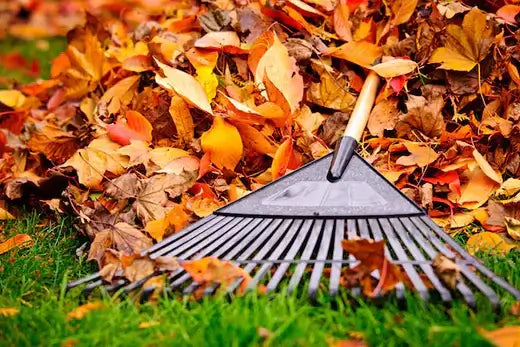Autumn is when you need to take care of the lawn and prepare it for the coming season.
It is crucial to plan and prepare your lawn for the winter season. If you take the necessary steps during this time of year, you can expect a healthy and thriving lawn in the spring.
Cleaning the lawn surface in autumn is crucial for maintaining healthy growing conditions for the grass. All dried leaves that fall on the ground during autumn should be raked, and the debris should be removed. If you let the debris of dried and diseased leaves remain on the lawn, the disease can spread to the lawn grass. After mowing, you should collect the grass cuttings as well from the ground; otherwise, they tend to dry and form thatch on the surface of the lawn.
Aerate the soil in several places by poking a fork or similar instrument for proper air circulation. This practice will also help rainwater to reach the roots of the grass readily. Spiking during this season helps in relieving stress due to compact cover and improves drainage.
Feeding the soil is another important aspect of lawn maintenance during the autumn season. It is essential to feed the lawn with nutrients so that the growth requirements are met. Lawn feed will help strengthen the grass, making it less prone to diseases and infections. Wide varieties of lawn feeds are available in the market, and you can purchase them to make your lawn stronger and greener. The lawn feed can be applied through a wheeled spreader if you have a large lawn. It can help you to accomplish the task effectively.
Autumn is the right time to redo bare patches. The wear and tear the lawn goes through throughout the year can result in bare patches that look very unappealing. They can ruin the entire look of your beautiful lawn. Once you have identified the patches that need to be repaired, just get to work by preparing the soil and removing weeds. The prepared area can be redone by sowing grass seeds and covering them with compost. Water the reseeded area frequently so that the germination of seeds occurs rapidly.
The care and maintenance of lawn grass can be tricky, but if done appropriately, it can ensure that you have a green and healthy garden all year round.
Affordable and Practical Autumn Lawn Care Tips
Autumn stands out as an essential time for lawn upkeep. As temperatures decrease and leaves begin to fall, taking special care of your lawn becomes necessary to maintain its health and vibrancy until spring arrives. The cost of lawn care doesn't need to exceed your budget. You can create a stunning yard through straightforward and affordable techniques that take advantage of household items you probably already own.
The first step in your routine should be to rake up and compost your fallen leaves. Leaves must be raked regularly since accumulated leaves can suffocate grass, leading to bare patches or brown spots during spring. Rather than disposing of fallen leaves, think about creating a compost pile in your backyard. Through composting, you can transform fallen leaves and kitchen scraps into nutrient-dense compost, which you can distribute over your lawn. Through this process, you achieve waste recycling and generate a cost-free natural fertilizer that encourages robust root growth.
To fix bare patches in your lawn, use a mixture of topsoil and compost to assist in overseeding. For areas with sparse grass, you must buy a small bag of grass seed (find one that matches your region) to distribute evenly across thin spots. A mixture of homemade compost and soil should cover the top layer of your seed bed. Your compost eliminates the necessity of costly fertilizers and soil amendments because it supplies all essential nutrients to your seeds.
Your kitchen scraps can become a natural soil amendment without a formal compost bin. Apply crushed eggshells across your grassy areas. Eggshells have calcium that benefits soil structure. A similar approach involves mixing leftover coffee grounds with water to spray over damaged areas of the lawn. Grass growth benefits from the gentle increase of nitrogen provided by coffee grounds. Applying these materials in small amounts is essential to prevent soil pH from becoming unbalanced.
You may stop mowing your lawn when weather temperatures drop. The long-term health of grass depends heavily on maintaining its height correctly. If grass gets too long during winter, it will become a host to insects and fungal growth. When trimming too short, grass blades become more susceptible to frost damage. To achieve a precise trim on your lawn, you should sharpen your mower blades with a metal file at home. To add organic matter, a mulching mower lets you leave finely chopped leaves on your lawn.
When autumn weather is mild, and your soil appears compact, perform aeration on your lawn. You don't necessarily need a pricey aerator. Access tools such as digging forks or spiked devices in your garage to create tiny holes throughout the compacted sections of your lawn. Aeration creates pathways for air and water to reach roots more efficiently while delivering nutrients that promote more substantial grass growth.
Ensure rainwater benefits your lawn by configuring gutters and downspouts to direct water appropriately toward its surface. Installing a basic rain barrel beneath a downspout can help lower your water expenses when supplemental lawn irrigation is necessary during dry periods.
The fall season is the perfect time to tend to your lawn outdoors before winter brings its cold temperatures. These affordable and environmentally friendly methods will help you achieve a beautiful spring lawn without causing financial stress.

